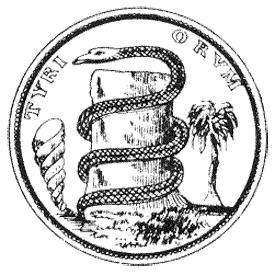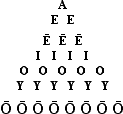
A PRELIMINARY ESTIMATE

"Part One is classic gnostic scripture, authoritative
works read by an ancient group that called themselves 'gnostics' -- 'people
fit to have acquaintance(GNOSIS) with God.' The name 'gnostic' most properly
applies to members of this group. In modern scholarship they are sometimes called
'SETHIANS', 'BARBELOITES', 'BARBELOGNOSTICS', 'OPHIANS' or 'OPHITES'. Most of
their scripture comes down to us in an obviously Christian or Christianized
form. The received Christian form is what is translated here. Some scholars
consider the Christian elements to be foreign to the original text."
-- Bentley Layton, The Gnostic Scriptures. Introduction, p. xv

-- The Holy Book of the Great Invisible Spirit (The Gospel of the Egyptians)


-- The Holy Book of the Great Invisible Spirit (The Gospel of the Egyptians)
"Snakes of Light become Grim Reapers" -- song lyric from "Sincerity" by Dave Ball and (the former) Genesis P.-Orridge.
IT is probably no great exaggeration to state that the subjects we are covering in our work have inspired the pens of so many hack writers, the result being that tons of rubbish have been printed in the years since Gutenberg revolutionized moveable type. The subjects of this chapter, the Ophites, and, in general, the Serpent Cult, is no exception. The Serpent Cult is no dead artifact: it survives today. It is not some heinous bogey-man, out to lure innocent people away from the truth, whoever they are, and what ever THAT is.
Serpent worship figures prominently in Judaeo-Christianity, even tho the so-called Christian of today is discouraged from it and told that the Serpent is the symbol of humankind's eternal damnation. Yet, were that the case, why was the Brazen Serpent a prominent feature in the religion of the Israelites until Hezekiah, the fanatic, destroyed it? And, if Serpent Worship is evil, as today's Christian is told to believe, by those responsible for telling them to believe it, then why did the Lord Jesus say to be wise as serpents? Or, why did he say that even as Moses lifted up the Serpent in the wilderness, so shall the Son of Man be lifted up? If anything, he was alluding to a fact of the Kabbalah, known to the Wise: that the Serpent = NaChaSh = 358 = MaShICh = Messiah. True, Gematria did not come into vogue until much later, but the Sethian Ophites regarded Seth as the Anointed One, the Messiah; and Seth, we have seen, is syncretized with Agathodaimon, by the Harranians.
It is, then, in the sect of Ophites that we find the earliest forms of the "Authentic Christianity" -- or, should we say, The Authentic Tradition in Christianity -- as far as the Initiatic Tradition is concerned. The Ebionites represented the Exoteric, public movement. The Esoteric current is that we have spoken of concerning the traditions that pass from the Ophites to the Dositheans to the Simonians to the Naasseni, to the Carpocratians, to the Phibionites, to the Sethians, to the Sethian Ophites, to the Barbelo-Gnostics, to the Borborites; to the Nusairi, to the Harranians, Druzes, and Yezidis: and from these again, to the Rose+Croix (SION + The Temple); to the Rosicrucians, Freemasons, Illuminati, the Asiatic Brethren; to the Thelemites and to ourselves, a composite of all of the above.
We could try and make bogus claims for ourselves if we wanted to, only to find them verified in the end. What we write is no exaggeration: We are the Heirs of this Ancient Gnosis.
In the same way that the tearing up of the rain forests has brought us into contact with exotic pests and diseases of which no known cure exists, the break-up of once-stable empires helped to spread rites, practices, ideas, and cultures all over the known world in times past. One of the earliest examples of this trend is that of the Indo-European invasions of the early second millennium B.C.E. Over the centuries, this cooled down, and it was not until the 10th Century B.C.E. that we find another major period of stress. Then, for about seven centuries the Near-East is rife with conflict, until Alexander the Great conquers it all and claims it as a prize. This is short-lived, of course, as his sons are inept managers of their respective inheritances and the Romans take advantage of the situation. Thus a new world order is created, with the Emperor at the top. This fares well for several centuries, until the system becomes over-burdened and bankrupt, and destroyed by the various barbarian tribes who become the new inheritors.
Then, after this has barely calmed down into the slow murky night of the dark ages, a new empire arises in Arabia. Islam, in one short century, owns most of the old Roman Empire, including all of Palestine. This lasts for nearly three centuries, until the Turks press down from the Northeast, as their sundry group of predecessors did to the Romans. Islam wanes, but does not go away. The Turks, after all, are Moslems, and use the new religion as a weapon against the Eastern Roman Empire and to scare the West. The smarter Arabs flee for Spain, where they bring with them the lost arts and sciences that once belonged to the Graeco-Roman legacy, and they have evolved nicely under the tutelage of their new caretakers. On and on, through the centuries, has this occurred; until very, very recently, the world is much more stable and peaceful than ever in its turbulent history.
While the Mandaeans may appear on the surface to be the group that met the Templars, we see no reason to accept it as proven fact. Even if Palaprat maintained it to be the case, since there is evidence that points to at least one other group of people, and possibly to others as well. The Rose + Croix tradition owes more to the Thebaid Solitaries and their relations in Syria; to the Harranians (who WERE Sabians), and to the Nusairis.
So, in the 10th Century B. C. E., the Ethiopians gained control of Egypt. The New Kingdom was over and done with. In the 10th Century B. C. E., the wandering guilds of builders and craftsmen known as the Dionysian Artificers appear in Athens, first, then move on to Ionia, Phoenicia, and Israel. In the 10th Century B. C. E., Solomon's Temple is built. In the 10th Century B. C. E., the Qadosh Fathers migrate north, from Egypt and settle in Israel, and probably in Phoenicia and the Greek Isles. This is when (perhaps a bit earlier) the action begins in the tale we excerpt below from Hargrave Jennings, in a once exceedingly rare book entitled Ophiolatreia.
Before we go into this important extract, though, we shall take up a subject that may be of interest to some.